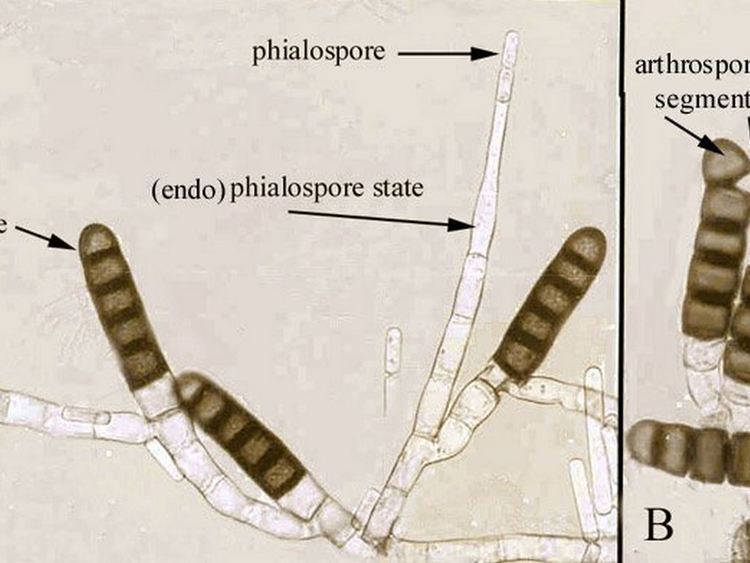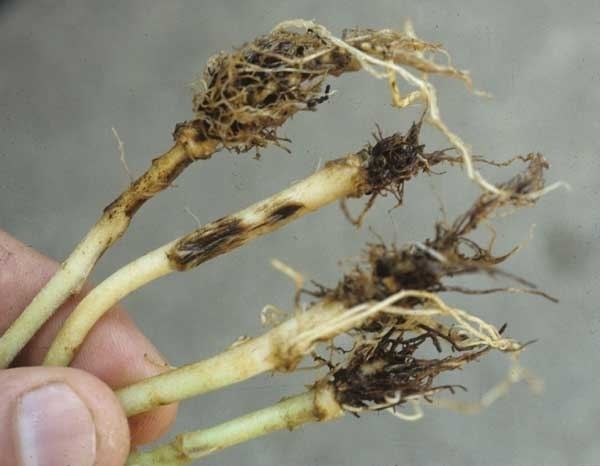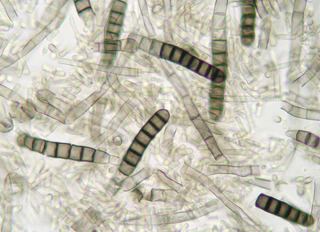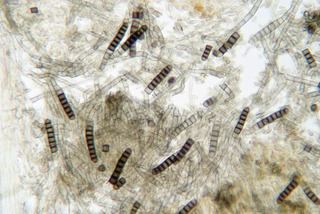Rank Species Higher classification Thielaviopsis Subclass Hypocreomycetidae | Scientific name Thielaviopsis basicola | |
 | ||
Similar Thielaviopsis, Rhizoctonia, Pythium ultimum, Pythium, Rhizoctonia solani | ||
Hosts and Symptoms

Thielaviopsis basicola is a plant-pathogenic fungus in the Ascomycota phylum. It is a soil-borne fungus that causes Black root rot. It has a wide host range consisting of gerbera, kalanchoe, pansy, petunia, poinsettia, primula, snapdragon, sweet pea, verbena, and viola. After T. basicola infects the host some of the symptoms consist of “stunting of foliage and root systems, blackened area on roots, yellowing of leaves between the veins or along the margins, and branch dieback. The yellowing of leaves means the plant cannot do photosynthesis and the blackened tissue means it is dead. And some of the signs include dark brown, multi-celled spores form in the infected roots. The individual cells appear to snap apart. Light colored spores are formed in a long tapering cell and extruded in chains”. If the hypocotyl along with the roots become infected it can lead to “black, rough, longitudinal cracks.”.
Contents
Disease Cycle

T. basicola is a soil inhabiting disease. The pathogen typically colonizes root tissue in the first two to eight weeks of crop growth. This causes cortical cell death which gives a brown to blackened appearance in the roots. The death of root cells also reduces development of new tissue in both roots and shoots. Once the fungus has successfully infected, it grows vegetatively via hyphae and produces the two types of spores. In this particular situation, state means imperfect form of the fungi. The “chalara state produces endospores (conidia) and the Thielavopsis produces aleuriospores (chlamydospores). Chlamydospores survive in soil for many years”. During wet and cool soil the spores will germinate. It is most “severe from 55° to 61°F, while only a trace of disease develops at 86°F. Alkaline soil favors the disease, which can be prevented at pH 4.8 and greatly reduced at pH 5.5 or below”. The fungus can “spread via vectors including- fungus gnats and shore flies, from infected roots to healthy roots if they come into contact with each other and when spores (conidia) are splashed from pot to pot when watered”.
Management

The first and foremost strategy for controlling T. basicola at the first sign of disease should be cultural control including- “maintaining a soil pH below 5.6, removing and destroying all diseased plants, using soil-less media, sterilizing equipment, keeping work areas clean, and controlling fungus gnats and shore flies. Fungus gnats and shore flies can be vectors; therefore, controlling these pests can lead to minimizing the spread of the fungus”. In addition, “crop rotation is recommended for management of black root rot. Soil fumigants, such as chloropicrin, can be helpful for controlling seedbed and sterol inhibitors”. Furthermore, “to avoid contamination of plants and potting media, greenhouse floors and walkways should be lightly misted with water to cut down on airborne dust transmission of T. basicola during cleaning operations”. At the end of the “growing season, doing a thorough clean-up of the greenhouse can be beneficial because it reduces the possibility of the fungus surviving as a resistant chlamydospores on the soil floor and in wooden benches".
Infected plants
See:



